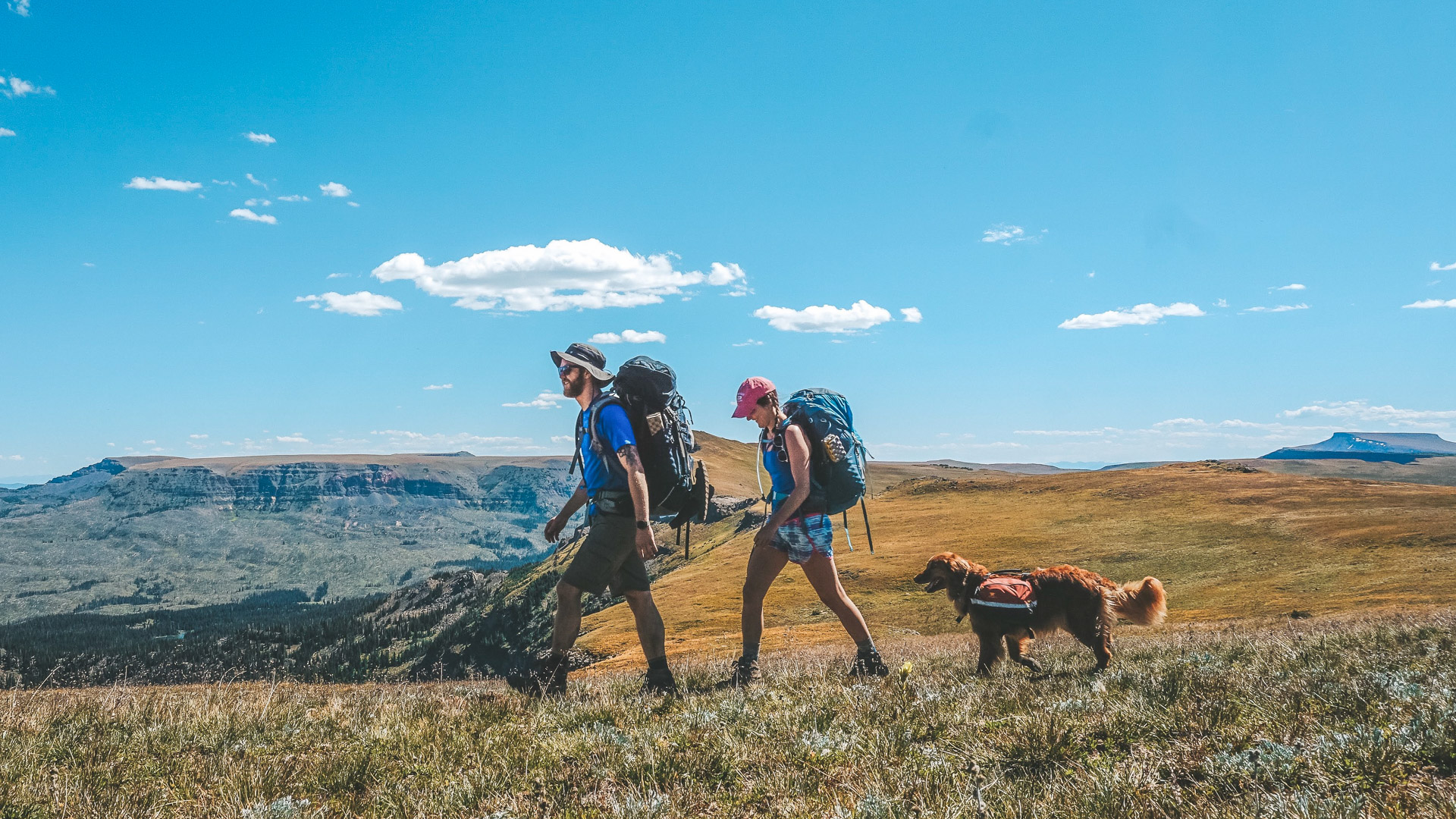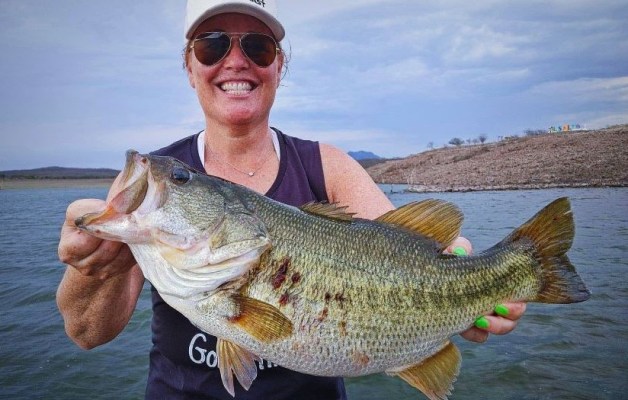
Before taking your dogs on their first overnight trip in the backcountry, I have a few tips to help make your trip a success!

Practice With The Tent
Have you ever met someone who’s NEVER been camping before? Chances are, they have a lot of questions about how you do it and what it’s like sleeping in a tent. Just like humans need to prepare for their first camping or backpacking trip, so do our dogs! And, it’s our job to help them. My first piece of advice before taking your dogs backpacking is to make sure they are comfortable sleeping and settling in a tent. While some dogs will walk right into a tent and sleep for the night, other dogs can be confused or struggle to settle down in the new environment. I recommend introducing them to the tent on a camping trip at an established campsite, or set up the tent in your backyard and hang out in there with them for practice beforehand. Reward them for calm behavior, spend some time relaxing in the tent, give them a bone or chew toy in the tent and enjoy some tent cuddles! This step may seem silly, but it’s much better to know if your dog has issues in the tent while you’re in a controlled environment rather than figuring it out as you’re setting up camp deep in the wilderness. And, even if your dog is comfortable in a tent, it’s great to set the expectation beforehand that the tent is a place of relaxation and sleep.

Start Small And Listen To Your Dog
Taking steps to make your dog more comfortable and prepared will help ensure that you both have the best trip possible. Another piece of preparation that I always recommend is building up stamina for your dog and knowing its limits. If your dog spends most of its days at home being a couch potato, it might enjoy the first few miles of your hike then quickly crash. Instead, build up its stamina with neighborhood walks, hikes and runs. Start small and build up in mileage and/or duration.
Always listen to your dog’s body language, and always go at its pace. If your dog refuses to move or seems more lethargic than normal, take a break and give it water! Be prepared to turn around at any point on the trail if your dog can’t make it any further, and if you see limping, that’s a sign to end your day. By not pushing too hard too soon, you can avoid injury and make it a new, fun bonding experience for you and your dog!

Use A Dog Backpack
A dog backpack is a great way for your dog to literally “carry its own” on the trail. If you want your dog to carry its pack on the trail, start with having it wear the pack around the house, eventually adding low, evenly distributed weight. Gradually increase to your target weight by practicing with the backpack for weeks or even months ahead of time.
There are a ton of options when it comes to dog backpacks, varying in size and function depending on the length of trip you’ll be doing. We use the Wilderdog Dog Backpack, and some of my favorite features are the handle, the spacious pockets and poop bag dispenser/storage. Our Wilderdog backpack always has plenty of space for one- to two-night backpacking trips. Some other great backpacks that we’ve had experience with are the Ruffwear Palisades Dog Backpack, which includes a removable harness and is a great size for multiday trips, and the Mountainsmith K9 Dog Pack, which offers tons of adjustment points for the perfect fit. My biggest recommendation when looking for a pack is to first find one that fits your pup comfortably, ideally one with a handle. The handle is one of my favorite features, and it comes in handy for situations like tricky creek crossings or big jumps.
And lastly, what should your dog carry? That’s totally up to you, but our girls typically carry their own food, a long line for camp, any smelly poop bags and their food and water bowls. Occasionally we’ll throw in a lightweight toy to play with at camp, too.

Research The Trail
Always research your trail before your backpacking trip, with or without a dog. But, it’s especially important when you plan on bringing your dog. Here are a few things that are important to consider when researching the trail that you plan to bring your dog on.
- Look up local regulations. Take the time to confirm that the trail allows dogs and whether any leash laws are in place.
- Check the weather. Be prepared for the weather for your trail location, and pack your dog an extra blanket or a jacket if the temperatures are dropping overnight. If it’s an especially sunny trail or warm day, plan lots of breaks for shade and water.
- Research trail conditions. Read recent trail reviews and trip reports on AllTrails. Know what to expect so you don’t get caught off guard by difficult obstacles, deep snow or treacherous river crossings.
- Understand the trail traffic. Whether it’s lightly, moderately or heavily trafficked might impact your experience and planning. For a lightly trafficked trail, you might need to consider and be prepared for wildlife sightings.
Avoid any last-minute surprises that could derail your trip by taking time to research beforehand.

Invest In Rescue Gear And A First-aid Kit
They are two pieces of gear you hope you’ll never need, but having them in your pack will make all the difference during a time of need. If you plan on getting into longer hiking and backpacking trips with your dog, I highly recommend investing in a rescue harness and a dog first-aid kit.
It’s every dog owner’s worst nightmare, but imagine your dog ripping open its paw pad or mysteriously limping toward you 5 miles into a trail. How are you going to get them out? It would be a pain and a risk to have to carry your dog while also navigating out of the trail. Your dog wouldn’t be completely secure (it could easily jump and hurt itself more), and you would be potentially risking your own safety or wellbeing by not having your hands free for balancing and hydrating. Instead, a dog rescue harness allows you to comfortably, safely and securely carry your dog off the trail, completely hands-free. There are a few different options on the market, but we personally use the Ruff Rescue Gear harness. It’s easy to throw in your backpack, plus the harness is ergonomic and comfortable for both you AND your pup.
Another easy addition to your pack or your dog’s pack is a dog first-aid kit. You can choose to assemble your own or buy one premade, but I prefer our premade Adventure Medical Kits Trail Dog Medical Kit since it also comes with a Pet First Aid Manual reference guide and handbook.

Protect Their Paws
A broken or injured paw pad on your backpacking trip is never fun. In fact, it’s an injury I actively try to avoid when heading into the backcountry. An injury to a paw pad can take days or even weeks to fully recover and often comes along with lots of bleeding. For that reason, we choose to use dog booties to protect our dogs’ paws. Paw balm is another option, although it will never provide the same level of protection as booties will.
Dog booties offer a nice, thick barrier between your dog’s paws and the ground and help to protect them from any potentially pointy, thorny or sharp objects. They are also great for both sunny days when the rocks/pavement is hot and cold days when ice and snow can build up between your dog’s toes. When putting on dog booties, it’s important to make sure you’re fastening them so that they don’t fall off along the trail! I always recommend securing the Velcro, then doing a quick “pull test.” If you can pull the booties off, try again and tighten the Velcro more! We use and love the QUMY dog booties from Amazon.
If you’d rather opt for paw balm, Musher’s Secret is our favorite brand. The paw balm will help to keep your dog’s paws moisturized, which prevents cracking that can lead to injury.

Keep Your Dog Under Control At All Times
While I could sit here and make a list of many reasons it’s important to keep your dog under control, it ultimately comes down to keeping it safe. Protect your dog from hazards on the trail by keeping it on a leash or long line or under voice control when off-leash (as regulations permit). You can’t predict another dog coming up the trail or wildlife around the corner, so keeping your dog on a leash or long line will always be the safest option.
When it comes to letting your dog off-leash while backpacking, it’s important to remember that you are on a hiking trail, not at a dog park. Your dog should have a reliable recall and should respect other hikers and their space in the same way that you do. Plus, it’s never fun to be the person chasing your dog in circles as it jumps on others and ignores your commands. If you pass other hikers, bikers or livestock on the trail, make sure your dog isn’t in a position to be blocking the trail. If you walk by others taking a break or relaxing at camp, call your dog into a heel or put it on a leash so it won’t intrude on their space (not everyone loves dogs as much as you!). And if you encounter another dog on the trail, never assume it’s OK for your dog to greet another dog; always ask or just pass without the dogs interacting. It’s not uncommon for dog-selective or dog-reactive dogs to be on the trail, so by being respectful and asking before greeting, you can keep everyone safe.
There are other hazards that you can run into on the trail that are harder to predict, such as plants and wildlife. For wildlife safety, the best thing you can do is keep your dog on-leash if it isn’t able to reliably recall to you when a deer, moose or even a squirrel is present. If you’re unsure, it’s best to keep your dog on-leash. If you want to give your dog a little more freedom, we’ve had great success using a 20- or 30-foot long-line leash to let them sniff and get some more zoomies, in a more controlled and safe way.
When it comes to plants, it’s important to have a “leave it” command to halt any chewing or investigating of dangerous plants, such as poison ivy or poison oak. Be especially cautious in fields of grasses, and be on the lookout for foxtails. If these barbed seed pods end up in your dog’s fur, between its paws or around its nose/eyes/ears, it’s important to remove them with tweezers right away. If you don’t see a foxtail but your dog is excessively tilting its head, rubbing at its face or showing signs of discomfort (and there are foxtails around), it’s time to cut the trip short and make a trip to the vet. Foxtails will embed themselves further and further into your dog, impacting vital organs, and can be fatal if not treated.
All that said, the best way you can keep your dog safe is by keeping it under control at all times. By being respectful of others’ space, knowing your dog’s recall reliability and using a leash as necessary, you can ensure the best time on the trail for everyone involved.




